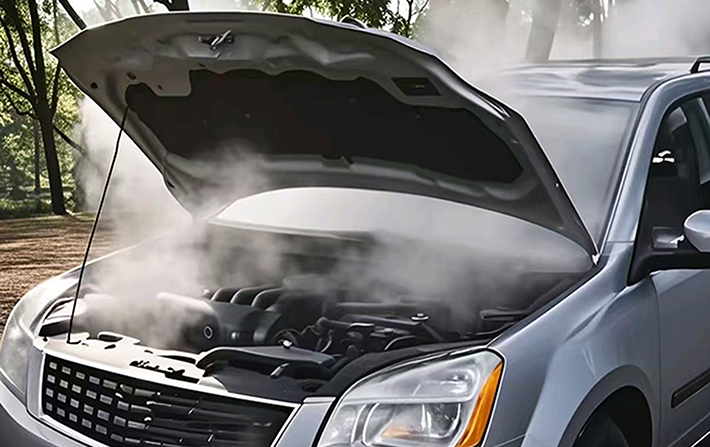Car radiator temperature is too high alarm how to do?
2025-02-28
When the temperature of the radiator is too high and the alarm is triggered, it indicates that there may be a problem with the cooling system, which may cause the engine to overheat or even cause serious damage if not handled in time. This article will give you a detailed answer to the radiator temperature is too high alarm causes, countermeasures and how to quickly cool down.

Radiator temperature is too high alarm reasons:
1. Insufficient coolant:Coolant is the key medium for radiator work, if the coolant leakage or evaporation causes the liquid level to be too low, the radiator can not effectively heat, the temperature will rise rapidly.
2. The heat sink fan is faulty:The fan is an important component for cooling the heat sink. If the fan does not work or the speed is too slow, the heat sink cannot dissipate heat in time, and the temperature rises rapidly.
3. The radiator is blocked:The surface of the radiator is blocked by dust and debris, or the internal blockage caused by scale and impurity accumulation will affect the heat dissipation effect.
4. Cooling system leakage:A leak in the coolant line, water pump, water tank, or radiator itself can lead to insufficient coolant, which can lead to excessive temperatures.
5. The temperature controller is faulty:The thermostat is responsible for regulating the flow of coolant. If the thermostat is stuck or fails, the coolant cannot circulate normally, and the temperature of the radiator will rise.
6. The water pump is faulty:The pump is the power source of the coolant circulation, if the pump is damaged, the coolant can not flow, and the radiator can not work normally.
Radiator temperature is too high alarm response steps:
1. Stop and turn off the engine immediately.
Operation: When the temperature alarm light on the instrument panel turns on, the vehicle should be parked in a safe area immediately and the engine should be turned off.
Reason: Continuing to drive will cause the engine temperature to rise further, which may cause serious failure.
2. Check the coolant level.
Operation:Open the engine hatch (pay attention to high temperature to avoid burns).Check the liquid level of the coolant storage tank to ensure that the liquid level is between MIN and MAX.If the coolant is insufficient, add an appropriate amount of coolant or distilled water (in case of emergency, pure water can be added, but it needs to be replaced with coolant afterwards).
Cause: Insufficient coolant is a common cause of excessive heat sink temperature.
3. Check whether the radiator fan works.
Operation:Check whether the fan works properly when the engine temperature rises.If the fan does not work, the circuit may be faulty, the fuse may be blown, or the fan motor is damaged, and further maintenance is required.
Cause: The fan is faulty, and the heat sink cannot effectively cool down.
4. Check whether the heat sink is blocked.
Operation:Check whether the surface of the radiator is blocked by debris. If necessary, clean it with compressed air or a soft brush.If you suspect internal blockage, go to a professional repair shop to clean or replace the radiator.
Cause: Heat sink blockage will affect the heat dissipation effect.
5. Check the cooling system for leaks.
Operation:Check whether the coolant pipe, water pump, radiator, and water tank have leakage traces. If leakage is found, repair and add coolant in time.
Cause: Coolant leakage will cause the radiator to not work properly.
How to Cool Down Fast:
1. Turn on the warm air:Turn the warm air inside the car to the highest temperature and turn on the maximum air volume, which helps to export engine heat to the outside of the car.
2. Cool naturally:Open the engine hatch after parking to allow heat to dissipate faster (pay attention to safety and avoid burns).
3. Spray water mist:Spray a small amount of water mist on the surface of the radiator (be careful not to pour cold water directly, lest the temperature difference is too large to cause damage to the parts).
Avoid wrong operation:
1. Do not open the radiator cover immediately. Opening the radiator cover in high temperature may cause the cooling liquid to spray out, causing burns.
2. Do not wash the engine directly with cold water, because the temperature difference will cause the engine cylinder block or radiator to crack.
subsequent processing:
1. If the temperature alarm light is turned off and the vehicle returns to normal, you can drive at low speed to the maintenance point for a comprehensive inspection.
2. If the fault occurs repeatedly, contact professional maintenance personnel as soon as possible to check whether components such as the water pump, thermostat, and radiator fan work properly.
Preventive measures:
1.Check the coolant level regularly and check the coolant level once a month to ensure that the liquid level is within the normal range.
2.Clean the radiator regularly, and clean the surface of the radiator once every six months or a year to prevent dust and debris from blocking.
3.Replace the coolant regularly, according to the requirements of the vehicle maintenance manual, replace the coolant regularly to avoid the accumulation of scale and impurities.
4.Check the components of the cooling system. Periodically check the working status of the water pump, thermostat, and fan to ensure the normal operation of the cooling system.
Summary
Through the above methods, you can effectively deal with the problem of excessive heat sink alarm, and avoid engine damage due to overheating. Regular maintenance of the cooling system is the key to preventing such problems. If the problem is complicated or cannot be solved by itself, it is recommended to contact professional maintenance personnel for handling.